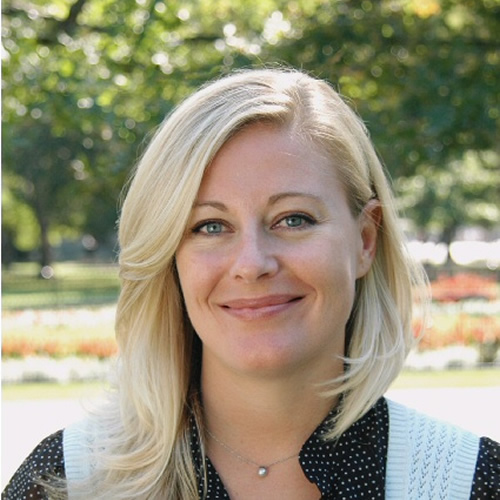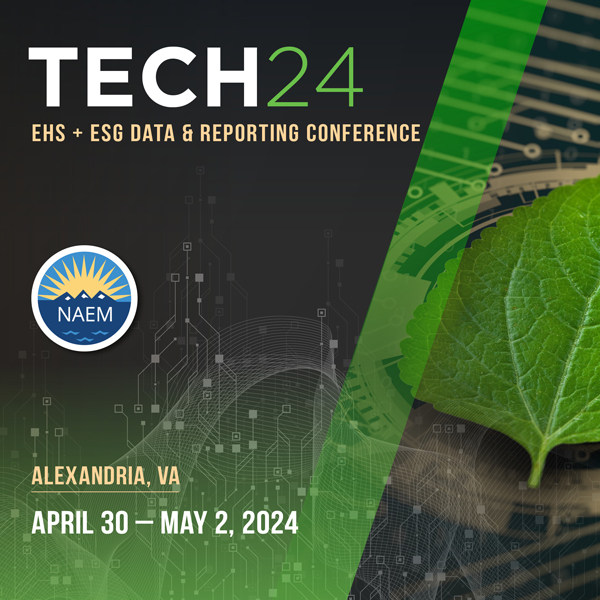Expert Q&A: Key Takeaways from the SEC Climate Disclosure Bill

NAEM’s Deputy Director Virginia Hoekenga sat down with Verena Radulovic, Vice President for Business Engagement at the Center for Climate and Energy Solutions (C2ES), to discuss the ruling and how it will impact companies as well as the EHS&S profession.
Hoekenga: What are your initial reactions to the new SEC climate disclosure bill?
Radulovic: The final rule is an important first step, and that’s great news since the rule will help elucidate what large, publicly traded companies are doing to address their climate-related financial risks. When the SEC issued notice that companies should disclose on their climate risks in 2010, there wasn't nearly as much guidance, metrics, or standards for how companies were assessing their climate impacts. Much has changed over the past 14 years. This rule provides more details for how companies should disclose how they are assessing and managing their climate risks.
That said, there are some details that the SEC could have gotten better. The final rule requires companies to disclose certain information, such as Scope 1 and 2 emissions, based on their interpretation of materiality. Since in many industries, particularly heavy manufacturing or energy supply industries, emissions are tied to their central operations or the products they create for consumers, it will be important to see how companies disclose their material risks or how they respond to material impacts.
Hoekenga: With the EU going further on Scope 3 emissions, do you think the SEC rule will still help advance climate transparency?
Radulovic: C2ES did advocate that Scope 3 emissions be included in the SEC rule, and we shared caveats for how the rule could handle the data quality and data uncertainty. However, even though the SEC rule ultimately did not include reporting of Scope 3 emissions, companies may still need to disclose, broadly, how they are addressing such emissions if they are material to their climate targets. Here, many companies are seeking greater clarity from the SEC.
Hoekenga: Overall, are there any places where rule elements could chill taking action?
Radulovic: I think the SEC did a good job of creating additional clarification on the application of safe harbors. The rule explicitly states that safe harbors apply to forward-looking statements, including their targets and transition plans. Doing so will hopefully provide companies additional comfort with issuing and updating their existing goals and plans. The biggest question is regarding companies that don’t yet have plans: Will they still create them knowing that they would have to report them? Will investor inquiry encourage companies to develop them, even if they are optional?
Hoekenga: Do you think the SEC gave enough flexibility for when the disclosures could happen?
Radulovic: I think so, because most companies that are reporting on their prior year’s greenhouse gas emissions are doing it in Q2 of the following year. It takes a couple of months, and for certain companies, it can take up to five or six months to gather data from the previous year. So, that flexibility enables companies to calculate and report the numbers once, as opposed to providing estimates and then having to go back three months later and give an updated number. Those three months aren’t going to make a big difference in understanding a company’s annual greenhouse gas inventory, and it reduces paperwork for the reporting company and the SEC alike.
Hoekenga: It seems like the U.S. and EU are now on two different regulatory paths. What are your thoughts?
Radulovic: That’s a great question, because the EU’s Corporate Sustainability Reporting Directive (CSRD) addresses climate as part of sustainability reporting, and the UK Transition Plan Taskforce (TPT) offers transition planning guidance for companies to position themselves to succeed in a low-carbon, climate resilient future. How companies are addressing their climate risks could ostensibly be part of those regulatory efforts. California’s regulations require companies to disclose more detail than the final SEC rule. I would imagine that for companies preparing to report to either or both the California and the EU regulations, reporting to the SEC could require marginal additional effort, despite initial up-front costs for updating internal data collection and reporting compliance systems. Greater guidance would be welcomed for how companies can most efficiently report to these different regulatory requirements, where several components of the regulations are similar or the same.
Hoekenga: Do you think that we'll eventually move towards a more harmonized set of standards and practices?
Radulovic: I think we are moving towards harmonized standards and practices, especially where they apply across industry sectors. For reporting on climate, many companies use the CDP and TCFDquestionnaires and frameworks. The GRI framework is much broader and all-encompassing for sustainability, where climate data reported into CDP can also be reported, at a high level, to GRI. The Greenhouse Gas Protocol (GHGP) and ISO 14064 standard have been in place for a long time, and serve as the underlying methodology by which companies measure their greenhouse gas emissions, setting the rules for reporting to CDP and in sustainability and/or TCFD reports. Corporate efforts to strengthen climate resilience and adaptation to the physical risks from a changing climate is a burgeoning area where best practices, guidance, and metrics are starting to be developed.
Where we are seeing harmonization is with the ISSB, which adopted the TCFD. ISSB and CSRD are already closely tied, and the UK’s TPT also used ISSB standards as its base. The SEC rule doesn’t specify which standard should be used; however, in its response to comments, it cites the GHGP and provides a minimum set of criteria for using greenhouse gas accounting standards that align with the GHGP.
Whereas general guidance and standards can apply across industry sectors as the basis for measurement and reporting, companies may need additional sector-specific guidance. Even within sectors, some reporting may likely reflect bespoke assessments, because companies are structured very differently and are measuring different risks. It's in the details that we're going to see differences in reporting across companies, but in a way that can still enable investors to have data that provides enough clarity and decision-useful insights to be able to compare companies.
Hoekenga: What are some of the critical skills that we're going to need in our field?
Radulovic: Large public companies have been reporting on sustainability and climate for a long time—at least two decades for greenhouse gas inventories in some cases. According to one estimate, 94% of the S&P is already reporting on climate performance. Many talented people are already working on engaging internal stakeholders, generating shareholder value, and mitigating risks, which should ostensibly reduce reporting burden. Durable corporate governance systems and ongoing support from the C-suite are needed to be able to effectively manage the response to the climate challenge over the next 25-30 years and beyond.
At the individual level, to comply with these evolving reporting regulations, various skills are needed across a company. Increasing reporting and implementation of climate actions will require input and buy-in across departments in strategy, governance, risk, and capital allocation. Sustainability professionals often need to have a systems-based view, or an understanding of how different departments enable the company as a whole, to assess climate risk and deliver on climate goals. Being able to connect and communicate with multiple departments, frame the value proposition and the opportunity and how this work is relevant to them, continue to be key skills that sustainability professionals need to be successful in their roles.
###
For more information and perspectives on the new SEC rule, check out the resources NAEM has assembled below.
SEC Final Rule Resources:
Sponsored Content
About the Author

Verena Radulovic
Center for Climate and Energy Solutions
Verena Radulovic is Vice President for Business Engagement at the Center for Climate and Energy Solutions.
Ms. Radulovic works with businesses, policymakers, and other stakeholders to advance business action on climate mitigation and resilience and help galvanize business support for ambitious, practical climate policies and solutions. She manages the Business Environmental Leadership Council (BELC), one of the largest U.S.-based cross-sectoral groups of corporations focused on addressing the challenges of climate change and supporting mandatory climate policy. Ms. Radulovic also oversees C2ES’ work on climate-related financial risk disclosure, supply chains, corporate greenhouse gas accounting, and climate resilience.
Previously, Ms. Radulovic led the Center for Corporate Climate Leadership at the U.S. Environmental Protection Agency (EPA), which provides greenhouse gas accounting guidance and resources to help organizations reduce their climate impacts. She brings over 15 years of experience managing public-private partnerships at the EPA.
Ms. Radulovic works with businesses, policymakers, and other stakeholders to advance business action on climate mitigation and resilience and help galvanize business support for ambitious, practical climate policies and solutions. She manages the Business Environmental Leadership Council (BELC), one of the largest U.S.-based cross-sectoral groups of corporations focused on addressing the challenges of climate change and supporting mandatory climate policy. Ms. Radulovic also oversees C2ES’ work on climate-related financial risk disclosure, supply chains, corporate greenhouse gas accounting, and climate resilience.
Previously, Ms. Radulovic led the Center for Corporate Climate Leadership at the U.S. Environmental Protection Agency (EPA), which provides greenhouse gas accounting guidance and resources to help organizations reduce their climate impacts. She brings over 15 years of experience managing public-private partnerships at the EPA.

Virginia Hoekenga
NAEM
Responsible for developing NAEM's educational programing, Virginia works closely with NAEM members to develop the annual EHS & Sustainability Management Forum, the largest gathering of EHS&S decision-makers. To get involved with the Forum, contact
her at [virginia at naem dot org].



